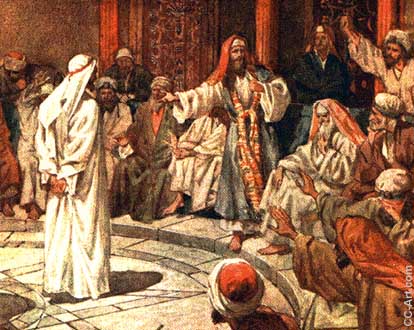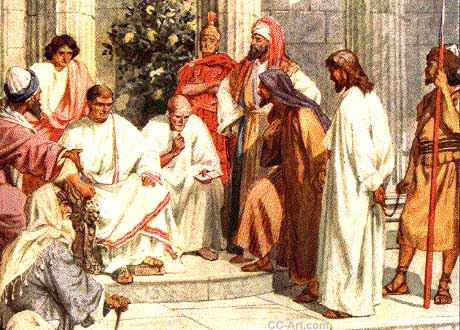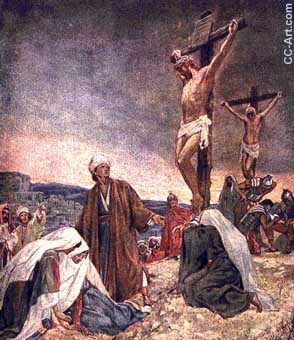

|

|
|
The high priest accuses Jesus of blasphemy. |
The high priest, all the chief priests, the elders and the scribes were waiting at the high priest's house. This was an informal late-night meeting of the Sanhedrin [SAN hee drun], the Jewish ruling council. They had come together to put Jesus on trial, but it was not to be a fair trial. The religious leaders were looking for evidence that would justify putting Jesus to death, but they could not find any. They called many witnesses against Jesus, but the witnesses did not agree with each other.
Finally, the high priest demanded of Jesus, "Tell us if you are the Messiah, the Son of God." Jesus replied, "I am, and you will see me, the Son of Man, sitting at God's right hand and coming back on the clouds of heaven." Then the high priest said, "You have just heard His blasphemy! Why do we need any more witnesses? What is your verdict?" They all shouted, "He deserves death!" Then they spat in Jesus' face and started beating Him.

|
|
The religious leaders take Jesus to Pilate and accuse Him falsely. |
Pilate saw that Jesus was not really guilty of anything and wanted to let Him go. But Pilate did not want trouble with the religious leaders. He asked Jesus, "Are you the king of the Jews?" Jesus replied, "My kingdom is not of this world. If it were, my followers would have fought to prevent my arrest by the Jewish leaders. But my kingdom is from another place."
It was the governor's custom to release one prisoner at the Passover Feast - anyone the people wanted released. The Jewish leaders knew this and had persuaded the crowd of people gathered around Pilate's house to call for the release of a criminal named Barabbas [buh RAB bas] and to demand that Jesus be crucified.
Pilate asked the crowd of people, "Which do you want me to release, Barabbas or Jesus?" The crowd yelled for Barabbas to be released. Pilate asked, "Then what should I do with Jesus?", and the crowd yelled "Crucify Him, Crucify Him!" So Pilate ordered the Roman soldiers to crucify Jesus.

|
| Jesus is crucified. |
The cross was placed between two other men who were being crucified that day. The soldiers nailed Jesus to the cross and left Him to die. They put a sign on the cross to mock Jesus that said, "Jesus of Nazareth, the King of the Jews."
About noon, strange things begin to happen. Darkness came over the land for three hours. Then Jesus cried out, "Father, into your hands I commend my spirit," and then He died. The curtain of the temple was mysteriously torn in two, and there was a great earthquake.
It was Friday afternoon, and the Sabbath would start at sundown. It was also a very special Sabbath because it was Passover. The Jewish leaders wanted all the bodies buried before the Sabbath started because they were not allowed to do any work on the Sabbath.
One of Jesus' followers, a man from the town of Arimathea named Joseph, went to Pilate and asked for Jesus' body. He took Jesus' body and hastily put it in a new tomb that had been carved in rock. He rolled a large stone in front of the tomb to seal it.
Jesus was the ultimate sacrifice to atone for the sins of all people. Through His death, we are freed from the deadly grip of sin. Although we do not fully understand the how or why of Jesus' sacrificial death, it offers us a chance for salvation, and that is the central belief and hope of Christianity.
But death on the cross was Jesus' destiny. Once the right time had come, Jesus did what was necessary to be sure it happened as planned. He angered His opponents with a bitter denunciation (Matthew 23). He offered no resistance when the chief priest's mob came to arrest Him. He refused to defend Himself before Pilate. Jesus, Himself, said those responsible for His death were doing God's will, even though they didn't know it (Matthew 26:53-54, Mark 10:33-34, John 12:24-28, 18:11, 19:10-11).
In describing the religious leaders, the Gospel of John sometimes uses the unfortunate shorthand "the Jews" instead of the longer "chief priests, elders and scribes." This has been used many times over the centuries as a pretext for persecuting Jews, but it is only a pretext to hide the true motives of prejudice and hatred. The first-century Jewish people as a whole were not responsible for Jesus' death, and their modern-day descendants certainly do not bear any guilt.